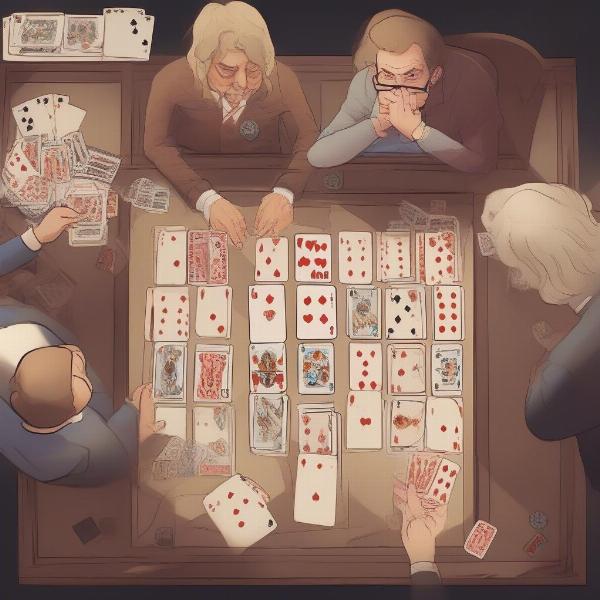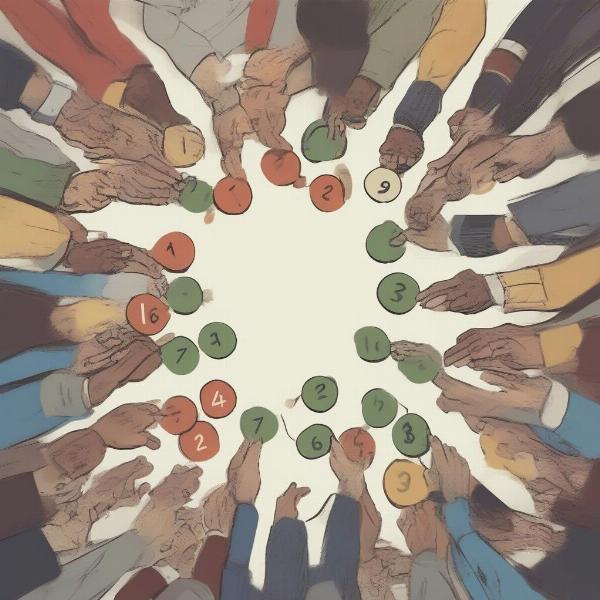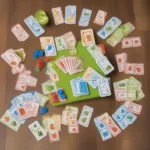Dive into the exciting world of Liar’s Liar, a captivating card game perfect for any gathering! This comprehensive guide will teach you everything you need to know, from the basic rules to advanced strategies, ensuring you become a Liar’s Liar master in no time. Let’s get started!
This deceptively simple game hinges on bluffing and deduction, making it endlessly entertaining. It’s a great game for parties, family nights, or even a quick break at work (though we wouldn’t recommend playing it during an important meeting!). Learning how to play Liar’s Liar is surprisingly easy, but mastering its subtle nuances takes time and practice.
What You’ll Need to Play Liar’s Liar
Before we dive into the rules, let’s gather the necessary components. You’ll need:
- A standard deck of 52 playing cards. No need for special editions or fancy designs; a standard deck will do perfectly.
- At least two players. Liar’s Liar is a game that can easily adapt to various group sizes, making it ideal for both small and large gatherings. The more players, the more chaotic and fun it gets!
- A level playing field (a table is recommended). This isn’t strictly necessary, but it makes the game easier to play and keeps the cards organized.
The Basic Rules of Liar’s Liar: A Step-by-Step Guide
Here’s a step-by-step guide to get you started. Remember, this is the basic version; we’ll delve into variations later.
- Dealing the Cards: Shuffle the deck thoroughly. Deal out all the cards evenly to each player.
- The First Player: The player to the left of the dealer starts the game.
- Playing a Card: This first player begins by placing one or more cards face down on the table, announcing the rank (number or face card) of the cards. For example, they might say “I’m playing two queens”.
- Subsequent Players: Each subsequent player must either:
- Add more cards of the announced rank to the pile, stating the total number of cards played. For example, if the first player put down two queens, the next player could add one or more queens, saying “Three queens.”
- Call “Liar!” if they believe the previous player is lying.
- Calling “Liar!”: If a player calls “Liar!”, the pile of cards is flipped over. If the previous player is telling the truth, the caller loses and takes all the cards. If the player was lying, they take all the cards.
- Winning the Game: The game continues until one player has collected all the cards. That player is the winner!
Variations on the Basic Rules: Adding a Twist
The basic rules of Liar’s Liar provide a solid foundation for the game, but there are several interesting variations you can explore to add a new dimension of strategy and excitement. Let’s examine a few of the most popular variants.
Allowing Multiple Ranks: Expanding the Possibilities
In some variations, players are allowed to play multiple ranks at once. For instance, a player might place down two queens and three kings and state, “I’m playing two queens and three kings”. This adds a significant layer of complexity, as players need to carefully track the number of each rank in play.
Adding a Penalty for Incorrect Calls: Raising the Stakes
To increase the strategic depth, you might introduce a penalty for calling “Liar!” incorrectly. Instead of simply taking the cards, the player who made the incorrect accusation could have to take an additional penalty, like drawing two cards from the deck. This would discourage careless accusations and incentivize more accurate assessments of each player’s claims.
Strategic Card Play: Beyond the Numbers
Mastering Liar’s Liar goes beyond simply counting cards. Consider these advanced strategies:
- Observation: Pay close attention to the discarded pile; this gives you clues on which cards other players might hold.
- Memory: Remember which cards have been played. This will help you in calling “Liar!” accurately.
- Bluffing: The art of bluffing is a crucial skill in Liar’s Liar. Learn to convincingly lie about the cards you have.
- Subtlety: Sometimes, even a small, well-placed lie can throw your opponents off. Avoid grand, obvious lies.
 Playing Liar's Liar: A Simple Guide
Playing Liar's Liar: A Simple Guide
Advanced Strategies for Winning Liar’s Liar
Want to become a Liar’s Liar champion? Here are some advanced strategies to help you along the way:
- Card Counting: Keep track of the cards played, including your own. This will help you predict which cards other players might have and make more informed decisions.
- Bluffing Techniques: Master the art of bluffing. Sometimes, a well-placed lie is more effective than the truth. Vary the size and frequency of your lies.
- Reading Your Opponents: Pay close attention to their behavior. Nervousness or hesitation can be signs they are bluffing.
- Observing the Discard Pile: The discard pile can be a valuable source of information, as it reveals which cards have already been played.
 Mastering Liar's Liar: Advanced Techniques
Mastering Liar's Liar: Advanced Techniques
How to Play Liar’s Liar with Different Numbers of Players
Liar’s Liar adapts well to various group sizes, making it a versatile game for almost any occasion. Here’s how to adjust the gameplay for different player counts:
- Two Players: A two-player game is less about bluffing and more about careful observation and deductive reasoning. Pay extra attention to the discard pile, as this will give you more information.
- Three to Five Players: This is often considered the ideal number of players, offering a balance between bluffing, deduction, and social dynamics.
- Larger Groups: With larger groups, the game becomes even more chaotic and fun. Bluffing becomes more important, as the larger number of players increases the chance of someone holding the cards you’re calling.
As Dr. Emily Carter, a renowned game theorist, notes: “Liar’s Liar’s beauty lies in its deceptively simple rules concealing a depth of strategic possibilities. Mastering the game requires not only keen observation but also a healthy dose of psychological insight.”
 Liar's Liar: Adapting to Different Group Sizes
Liar's Liar: Adapting to Different Group Sizes
Frequently Asked Questions about Liar’s Liar
What happens if someone calls “Liar!” and they are wrong?
If a player calls “Liar!” incorrectly, they take all the cards in the pile.
Can I play more than one card of the same rank at a time?
In the basic version, you can only play one card at a time. However, many variations allow players to play multiple cards of the same rank.
What if I run out of cards?
The game continues until one player holds all the cards. If you run out of cards, you are still in the game; just pay close attention to what other players are doing.
Is there a way to increase the difficulty of the game?
You can increase the difficulty by adding variations like playing multiple ranks at once or introducing penalties for incorrect “Liar!” calls.
Can I use Jokers in Liar’s Liar?
No, Jokers are typically not used in Liar’s Liar. The game uses a standard 52-card deck.
How long does a game of Liar’s Liar usually last?
The length of the game varies depending on the number of players and their skill level. It usually lasts from 10 to 20 minutes.
What is the best strategy for playing Liar’s Liar?
The best strategy is a blend of careful observation, memory, bluffing, and deduction. Pay attention to the discarded cards, remember what has already been played, and learn to convincingly lie when needed. For more on card games for two, check out our guide on two person drinking card games. For those interested in slightly more complex card games, you may enjoy reading our article on rules to shanghai card game.
Conclusion: Mastering the Art of Deception
Liar’s Liar is more than just a card game; it’s a test of your observation skills, your ability to bluff, and your capacity for deduction. By understanding the basic rules and mastering the advanced strategies, you’ll be well on your way to becoming a Liar’s Liar champion. So gather your friends, shuffle the deck, and prepare for a night of exciting gameplay and strategic deception! Remember to share this guide with your friends and challenge them to a game! For those curious about other card game distributors, our blog post on top deck cards & games llc might pique your interest. If you’re a fan of collectible card games, be sure to take a look at our article on the one piece trading card game romance dawn. And finally, if you enjoy games with a bit more strategy, consider checking out our detailed guide on card games similar to euchre.

